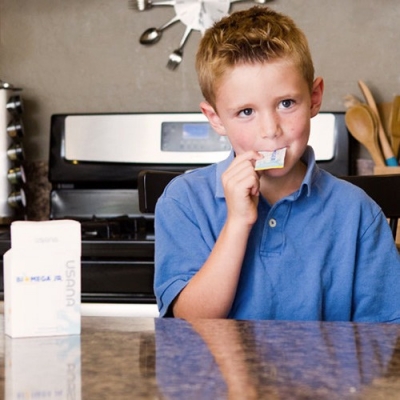USANA® BiOmega Jr.™
Healthy Brains and Bodies Get a Smart Start with USANA® BiOmega Jr.™
BiOmega Jr.
Make it fun for your little one to get a healthy squeeze of omega-3s from fish oil, plus vitamin D in a tasty orange-pineapple gel.
In parenting, sometimes you have to pick your battles. You know it’s important for your child to get a full range of nutrients to grow up healthy. But that can seem like an insurmountable task when getting kids to eat something—anything—resembling real food is challenging. Never mind sitting down for a healthy fish dinner! USANA BiOmega Jr. can help save your sanity and stop the table-time tantrums (well, maybe some of them). Give your little one the benefits of the good fats from fish without the fight. BiOmega Jr. is a tasty, tropical-flavored omega-3 plus vitamin D supplement they will actually look forward to.
The healthy amount of omega-3 fatty acids from fish oil in BiOmega Jr. won’t leave a fishy aftertaste. This will make it easier to ensure your child gets the important omega-3 fats—especially DHA, EPA—along with a boost of the vitamin D they need to help support:
- Healthy growth and development*
- Healthy brain function*
BiOmega Jr. comes in convenient single-serving packets. So, it can easily be used by children 4-years and older, teens, and adults who have difficulty swallowing tablets and capsules. The orange-pineapple flavored gel hides the fishy flavor, and it can be eaten straight from the packet (best served chilled). Or you can add it to creamy, cool foods, like yogurt or smoothies.
Help support your child’s healthy mind and body with an omega-3 supplement that isn’t full of added sugar. They’ll look forward to having BiOmega Jr. as a treat, every other day. And when you pair BiOmega Jr. with Usanimals™, you’ll feel great knowing you’ve met many of their important nutritional needs. Even if the rest of their diet that day is less than ideal.*
BiOmega Jr. Reels In a Healthy Dose of Beneficial Fats from Fish
Nutrition is key to getting a child off to a healthy start. You may think of a multivitamin to provide vitamins, minerals, and antioxidants. But don’t forget the importance of a balanced diet that also includes the right kind of fats.
Fats are an essential part of any child’s diet. And, limiting unhealthy fats, while also encouraging consumption of healthy ones, is the key to setting a solid foundation of good nutrition for life.
Unfortunately, many children prefer to overeat foods that contain only saturated or trans-fats, like meat, milk, and cheese. Consuming too much of these types of fat isn’t beneficial for your child’s health.
Monounsaturated fats found in plant foods and polyunsaturated fatty acids, like omega-3 fatty acids, are great additions to their diet. Some of the most beneficial and well-studied fats for health are omega-3s, especially EPA (eicosapentaenoic acid) and DHA (docosahexaenoic acid).
USANA’s BiOmega Jr. can help you add a highly bioavailable source of omega-3s to your child’s diet. The emulsion delivers a concentrated amount of ultra-refined, sustainably sourced fish oil in a tasty orange-pineapple flavored gel. Each packet provides 650 milligrams (mg) of total omega-3s, containing 350 mg of EPA and 230 mg of DHA. BiOmega Jr. is also an excellent source of vitamin D3. Together, these ingredients can help support your child’s healthy growth and development.*
Why is an Omega-3 Supplement Important for Kids?
A growing body of research shows the importance of EPA and DHA omega-3 fatty acids for overall health, even at the earliest stages of life. Because it’s well known how important these vital nutrients are, pregnant women and new mothers often supplement their diets. And most infant formula is now fortified with omega-3s to help support a baby’s growing brain and body in the first years of life.*
But when a child transitions to eating solid foods, the amount of omega-3s in their diet may drop dramatically and stay low throughout childhood. And, not surprisingly, reports suggest this is indeed the case: nearly 80 percent of children in North America don’t get enough omega-3s in their diet. This shortage appears to be common in children outside of North America, as well. Most also fall short on vitamin D consumption.
The best way to maintain optimal levels of omega-3s in the body is to get them directly from the diet. So, to help make sure your child gets a healthy amount of these beneficial fats, start by encouraging them to eat these sources of omega-3s regularly:
- Salmon, wild tuna, mackerel, sardines, herring, and other fish (unfortunately, most breaded fish sticks don’t have nearly as much omega-3s in them)
- Seeds (chia, flax), edamame, and nuts (walnuts)
- Fortified foods, such as eggs, juice, or yogurt
Fortified foods and fatty fish, eggs, and yogurt can also be sources of vitamin D. The amounts are often low, though. So, a supplement is a great solution to provide your child with more vitamin D, as well.
You can also give a packet of BiOmega Jr. to your child every other day, especially if they’re finicky and won’t eat many of the foods listed above. It’s a stress-free way to make sure their growing body will have the good fats and vitamin D it needs to support normal growth and development.*
Catch the Benefits of BiOmega Jr. for a Growing Body
Developing a healthy body early in life can have long-term, positive benefits into adulthood. And your child’s development and overall health need adequate intakes of omega-3 fatty acids, including EPA and DHA, as well as vitamin D to support the healthy function of many different parts of the body:*
- Immune system*
- Skin*
- Eyes and visual function*
- Cardiovascular system*
- Bones and teeth*
Omega-3 fatty acids support so many different aspects of health because of their central role in the body. They help keep cells healthy and functioning properly. They do this by absorbing into cellular membranes to keep them fluid and permeable (so substances can pass into and out of them).
Fluid cellular membranes are important for many reasons. One is helping cells readily absorb nutrients from your child’s diet to fuel various processes they need to perform. This includes building more cells that will be needed as your child’s body grows. This makes BiOmega Jr. a great way to ensure your child’s cells can optimally absorb nutrients from the foods they eat.*
Omega-3s are also vital for the production of important signaling molecules, which are messengers that carry information. These molecules—known as eicosanoids—are needed to direct many biochemical processes and interactions between cells. Eicosanoids influence healthy function of the muscles, circulatory system, immune system, digestive system, and more.*
Vitamin D is also important for the healthy function of virtually every cell in your child’s body. There are vitamin D receptors on most tissue cells, including those in their muscles, skin, nervous system, and thyroid. And, of course, vitamin D is key in supporting the development of strong healthy bones and teeth by supporting proper calcium use by the body. This makes vitamin D equally essential as omega-3s for a growing body.*
BiOmega Jr. Helps Feed a Growing Brain for a Smart Start
Children learn more quickly during their early years than at any other time. It’s when they learn the skills and behaviors that will stick with them for the rest of their lives. This means supporting a healthy brain is important for establishing a smart start for your child’s future.*
Over half of the brain is fat. And DHA is the most concentrated polyunsaturated fat in the brain, eyes, and nervous system. So, by feeding your child’s body the DHA it needs, BiOmega Jr. helps support the proper structure and function of their developing brain.*
This structural support of brain cells helps them can relay information, and may help support many aspects of cognitive development:*
- Learning ability*
- Vocabulary acquisition*
- Listening comprehension*
- Acute memory*
- Attention and concentration*
- Behavior and mood*
The omega-3s in BiOmega Jr. are needed throughout the brain to support good communication between cells. In fact, their role in communication is so important that healthy brain cell membranes contain over 10 times more omega-3s than the rest of the body. They help keep information flowing by creating an optimal environment for sending and receiving messages in the brain.*
The messages in the brain and nervous system are sent by specialized cells—neurons. They use electrical and chemical signaling to pass information along. And fluid cell membranes are one element that’s critical for transmitting those signals.
When DHA is absorbed into neuronal membranes, it does more than support fluidity. It also supports the formation of the new neural networks required for learning and memory.*
Your child’s growing brain uses DHA to support the production of new neurons and synapses, which are junctions where messages are passed between cells. The omega-3s in neuronal membranes also help promote synaptic plasticity and function. This is what allows the brain to reshape itself to adapt to and store new information.*
As you can see, omega-3s play many roles in supporting growing brains and bodies. BiOmega Jr. can give your little one a tasty squeeze of the essential nutrition that will help them thrive.
Usage
Ages 4–12 years—take one (2.5 gram) packet every other day with or without food. Serve chilled for an even better taste.
Ideal For
- Children 4 years and older
- Teens
- Healthy adults with difficulty swallowing tablets
Why does BiOmega Jr. contain potassium sorbate and sodium benzoate?
Foodborne illness caused by microbes or pathogens is a common and costly public health problem. Each year, thousands of people are sickened by consuming contaminated foods or beverages. The young and the elderly are most susceptible to food borne contamination. Many different disease-causing microbes, or pathogens, can contaminate foods, so there are many different foodborne infections. By inhibiting the growth of microorganisms, preservatives help prevent outbreaks of food-borne illnesses. Potassium sorbate and sodium benzoate are the preservatives included in Biomega Junior to inhibit the growth of microbes and pathogens.
Your health and the health of your children are very important. At USANA, we review all relevant and necessary materials and research when formulating products to ensure safety, efficacy, and compatibility. Because of this initial research and testing of final products, you can be assured that we have done our due diligence with regards to product safety and efficacy.
References
https://www.ncbi.nlm.nih.gov/pubmed/10617967
https://www.ncbi.nlm.nih.gov/pubmed/19201180
https://www.ncbi.nlm.nih.gov/pmc/articles/PMC2621042/
https://www.ncbi.nlm.nih.gov/pubmed/15333721
https://www.ncbi.nlm.nih.gov/pubmed/15524182
https://www.ncbi.nlm.nih.gov/pubmed/12438303
https://www.ncbi.nlm.nih.gov/pubmed/19158221
https://www.ncbi.nlm.nih.gov/pubmed/18180340
https://www.ncbi.nlm.nih.gov/pubmed/17435458
https://www.ncbi.nlm.nih.gov/pubmed/11157330
https://www.ncbi.nlm.nih.gov/pubmed/18779299
https://www.ncbi.nlm.nih.gov/pubmed/15129302
https://www.ncbi.nlm.nih.gov/pubmed/19064511
https://www.ncbi.nlm.nih.gov/pubmed/19255005
https://www.ncbi.nlm.nih.gov/pubmed/14597910
http://www.health.nsw.gov.au/pubs/2006/spans
https://www.ncbi.nlm.nih.gov/pubmed/26688435
https://www.ncbi.nlm.nih.gov/pmc/articles/PMC5751211/
https://www.ncbi.nlm.nih.gov/pubmed/1908631
https://www.ncbi.nlm.nih.gov/pubmed/20620762
https://www.ncbi.nlm.nih.gov/pmc/articles/PMC5417803/
https://academic.oup.com/ajcn/article/88/2/491S/4649916
https://www.ncbi.nlm.nih.gov/pubmed/27842299
https://ods.od.nih.gov/factsheets/Omega3FattyAcids-HealthProfessional/
http://www.dhaomega3.org/Overview/DHA-for-Optimal-Brain-and-Visual-Functioning
https://www.ncbi.nlm.nih.gov/pmc/articles/PMC4728620/
https://www.ncbi.nlm.nih.gov/pmc/articles/PMC3738999/
https://www.ncbi.nlm.nih.gov/pmc/articles/PMC2844685/
https://www.ncbi.nlm.nih.gov/pubmed/25713056
https://www.ncbi.nlm.nih.gov/pubmed/25054550
https://www.ncbi.nlm.nih.gov/pmc/articles/PMC3792211/
https://www.ncbi.nlm.nih.gov/pmc/articles/PMC4743082/
https://qbi.uq.edu.au/brain-basics/brain/brain-physiology/what-synaptic-plasticity
https://www.nature.com/scitable/topicpage/fatty-acid-molecules-a-role-in-cell-14231940
https://www.ncbi.nlm.nih.gov/pubmed/27288396
https://www.coromega.com/faq
Checking the Facts About Children’s Nutrition
Children’s nutrition is important to support growing minds and bodies. Focusing on a healthy, balanced diet—and proper supplementation are key.
Growing Up Healthy: Proper Nutrition for Kids as They Age
Kids’ nutritional needs change as they age. Learn what healthy kids need at different ages to help them grow. Also, discover tips about nutrition for kids.
Kids in the Kitchen: Tips for Cooking as a Family
Cooking with kids doesn’t have to be a mess. Discover the benefits of cooking as a family, how to prepare, and tips for family cooking.
*These statements have not been evaluated by the Food & Drug Administration. This product is not intended to diagnose, treat, cure, or prevent any disease.











